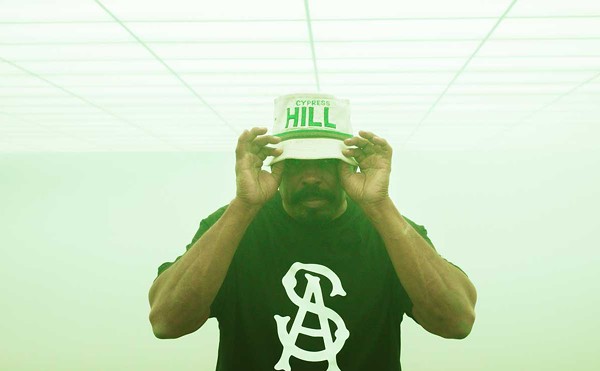Seventeen years ago, in London, after a rehearsal for a BBC-sponsored performance of composer Edgar Varèse's Ecuatorial, a ham-fisted stagehand whanged the ondes Martenot — one of two featured in the piece — played by Cynthia Millar, effectively putting the instrument out of commission. Given the scarcity of the decidedly peculiar electronic keyboard (fewer than 300 have been produced, all handcrafted by its inventor, Maurice Martenot, who died in 1980), BBC officials openly fretted about securing a replacement. Not to worry, Millar's co-ondist, Jeanne Loriod, said when informed of the dilemma — she just happened to have another in the trunk of her car. "I always have a spare one," Loriod asserted. "You never know what can happen."
That Loriod should tool around with an extra ondes Martenot (translated from French: "Martenot's waves") in her car should come as no cosmic slap upside the head: Over a half-century she became singularly identified with the obscure instrument, not only as its unrivaled master player, but also as its tireless cheerleader, relentless commissioner of works, foremost instructor, and authoritative textbook writer.
A complex mechanism that, outwardly at least, looks as if it would be equally at home in the hands of an electrical engineer as a conservatory-trained pianist, the seven-octave ondes Martenot is powered by a pair of high-frequency oscillators that transmit sound through a trio of separate, mounted "diffusors": one palm-shaped, webbed on either side by a network of guitarlike strings; one gong-shaped; one a conventional loudspeaker. Seated at the keyboard, the ondist produces pitch with the right hand, while the left hand determines volume, filter settings, and speaker selection via a control-panel drawer located in the instrument's extreme left-hand corner. Rocket-ascending or meteor-descending glissandi are created with a metal ring grasped in the right hand. A skilled player can coax a panoply of sounds from the ondes, from a ghostly quaver to a mournful warble to a thunderous blast. No one mastered its nuances like Loriod.
The instrument and the musician seemed destined to coalesce from birth. On April 20, 1928, Martenot unveiled his invention when he premiered Greek composer Dimitrios Levidis' haunted Poème symphonique at the Paris Opera; less than three months later Loriod was born in Houilles, just west of Paris. She followed her older sister Yvonne to the Paris Conservatoire, where both studied piano. In 1947 Jeanne signed up for a class taught by Martenot, quickly became bewitched by his ondes, and three years later joined an ondes quartet led by Martenot's sister Ginette.
Loriod devoted the rest of her life to the instrument, expanding its repertoire, resurrecting its forgotten pieces, and teaching its perplexing idiosyncrasies. While she performed ondes works written by various established modern composers — Varèse, Arthur Honegger, Darius Milhaud, Charles Koechlin, Florent Schmitt, André Jolivet, Jacques Ibert — she became most associated with several created by Olivier Messiaen, principally his dynamic and challenging Turangalîla-symphonie, which she recorded a half-dozen times, often accompanied on record and in concert on the piano by her sister (who, not incidentally, married Messiaen in 1961). Messiaen appreciated the innate sonic possibilities of the ondes, characterizing what emanated from its loudspeakers as the "impalpable sounds of dream." Specifically for Jeanne, he included a trio of ondes parts in his opera Saint François d'Assise.
With the intention of reanimating Messiaen's early works, commissioning new material by a passel of contemporary composers, and writing some of her own, Loriod founded the Jeanne Loriod Sextet in 1974. Ultimately, her repertoire ballooned to 300 pieces with concertante parts for ondes, 250 chamber works, and 15 concertos, not forgetting her ondes contributions to Maurice Jarre's soundtracks for the films Lawrence of Arabia and Mad Max: Beyond Thunderdome. And when she drowned in August at the age of 73 after suffering a stroke while swimming near Antibes on the French Riviera, talk had been circulating about a Loriod/Radiohead collaboration.
That seemed reasonable because Loriod, irrespective of genre, intuitively understood the sometimes nebulous components of musicianship. In Technique de l'onde électronique type Martenot, her definitive three-volume 1987 teaching text, she wrote that her particular instrument required "talent, indiscriminate and inexplicable . . . the mysterious alchemy between the innate and the acquired . . . conscious thought and physical mastery working simultaneously."
At the Drive-In - Samuel Z. Arkoff, 1918-2001
The Art of Living - Balthus, 1908-2001
No Big Eyes - Jane Greer, 1924-2001
Living in Darkness - James Carr, 1942-2001
Talkin' Picture - Fred Neil, 1936-2001
The Smell of the Grease Pit - Ed "Big Daddy" Roth, 1932-2001
Do the Math - Iannis Xenakis, 1922-2001
People who died - A salute to some of 2001's dear departed cult culture heroes





